Substitute for Beans in Chili
You can substitute beans in chili with several tasty alternatives that maintain the dish's hearty texture. For every 15-ounce can of beans, try adding ½ pound of extra ground meat, 1½ cups of cauliflower rice, or 1 to 1½ cups of chopped mushrooms. Sweet potatoes and butternut squash work well too, offering natural sweetness and bulk. If you're following a low-carb diet, ground meat alternatives provide protein while keeping carbs low. For vegetarian options, TVP (textured vegetable protein) mimics ground meat's texture while delivering 50 grams of protein per 100 grams. These substitutions just scratch the surface of creating delicious bean-free chili.
This post may contain affiliate links. If you make a purchase through these links, I may earn a commission at no additional cost to you. Additionally, portions of this post may be generated using artificial intelligence (AI) technology. While we strive for accuracy, please be aware that AI-generated content may not always be perfect and should be fact-checked when necessary.
The Spatula Scoops
- Ground meat can replace beans at ½ pound per 15-ounce can, providing protein and maintaining chili's hearty texture.
- Cauliflower rice serves as a low-carb substitute, using 1½ cups of chopped cauliflower per can of beans.
- Mushrooms add meaty texture and umami flavor, substituting 1 to 1½ cups of chopped mushrooms per can of beans.
- Sweet potatoes or butternut squash can replace beans one-for-one, offering natural sweetness and maintaining structural integrity.
- Textured Vegetable Protein (TVP) mimics ground meat texture and provides 50 grams of protein per 100 grams when hydrated.
Why Skip the Beans
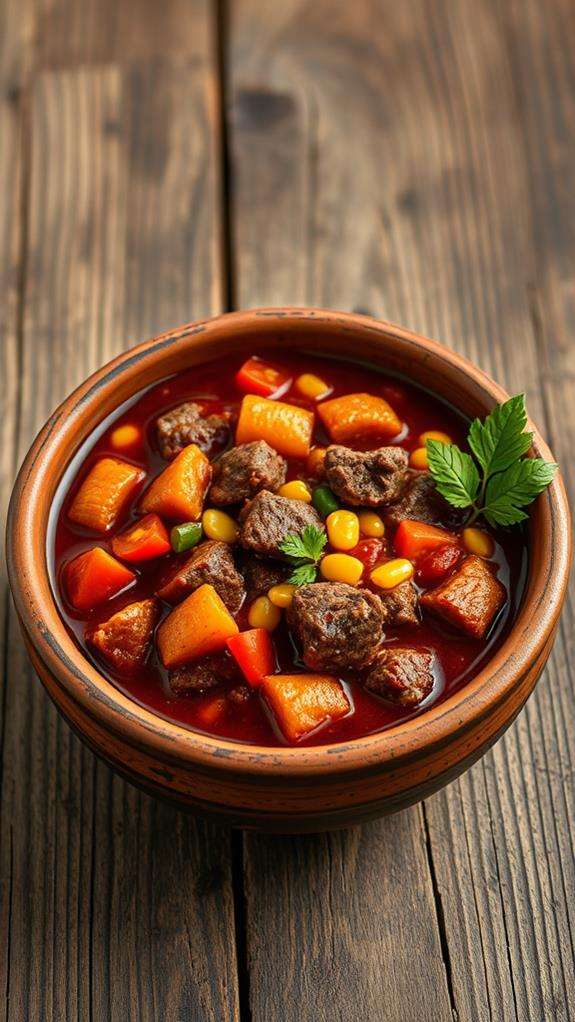
Whether you're following a low-carb diet or dealing with digestive sensitivities, there are compelling reasons to skip beans in your chili. For those committed to ketogenic or low-carb lifestyles, traditional beans in chili can quickly consume your daily carbohydrate allowance, making it challenging to stay within your dietary goals. Additionally, if you've experienced digestive discomfort after eating beans, you'll find that no-bean chili offers a more comfortable dining experience without sacrificing flavor.
Making the switch to bean-free chili can actually enhance your culinary experience in unexpected ways. You'll notice that without beans, your chili develops a richer, meatier texture that many people prefer. The absence of beans also means shorter cooking times, allowing you to prepare a delicious meal in under an hour. You'll have more room in your pot for alternative ingredients that can boost both nutrition and flavor, such as diced vegetables or hearty mushrooms. These substitutions not only maintain the satisfying nature of traditional chili but also create a customizable dish that better suits your dietary needs and preferences.
Ground Meat Alternatives
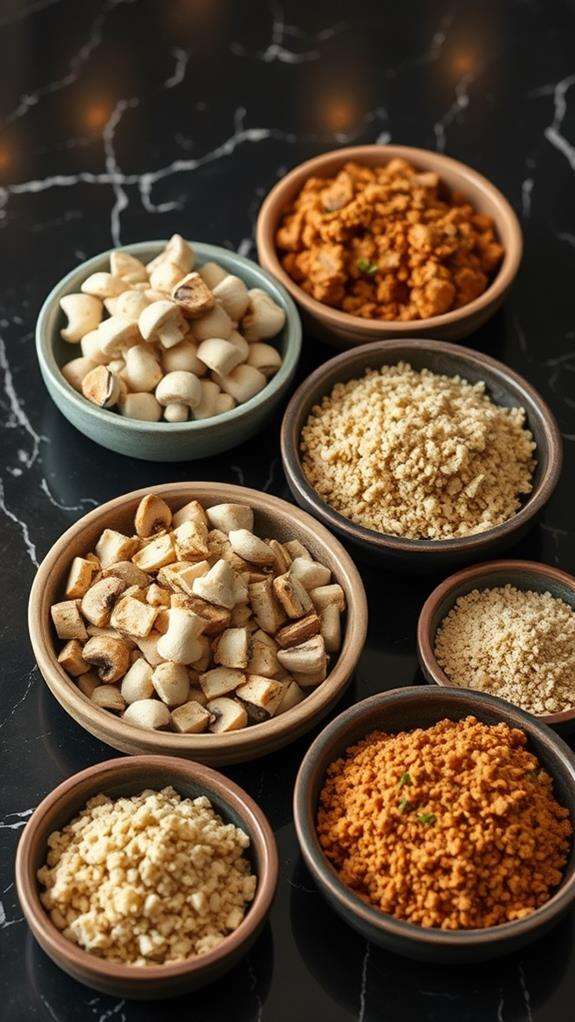
When replacing beans in your chili, you'll want to follow a basic ratio of ½ pound of ground meat per can of beans you're substituting, ensuring your chili maintains its hearty texture and protein content. Ground beef serves as a classic choice, offering rich flavor and satisfying depth, while ground turkey provides a leaner alternative that still works beautifully with traditional chili seasonings. You can further customize your bean-free chili by mixing different ground meats, such as combining beef and turkey for a balance of flavor and nutrition, or opting for ground chicken if you prefer a lighter profile.
Meat-to-Bean Ratio Guidelines
For a successful bean-free chili, understanding the right meat-to-bean ratio is crucial. When you're adapting traditional chili recipes, you'll want to use ½ pound of ground meat for every 15-ounce can of beans you're replacing. This ratio guarantees your chili maintains its hearty texture and satisfying volume.
For the best results in your bean-free chili, consider these key guidelines:
- Choose extra-lean ground beef (93% lean) to prevent excess grease and maintain an ideal consistency
- Substitute ground turkey or chicken as lighter alternatives that still deliver rich flavor
- Adjust your cooking time downward, as ground meat cooks faster than beans
When you're working with lean ground beef or other meat alternatives, you'll find that this substitution not only maintains the dish's protein content but also creates a satisfying, lower-carbohydrate meal. The meat-to-bean conversion isn't just about volume—it's about achieving the right balance of flavors and textures. You'll notice that ground meat adds depth to your chili while requiring less cooking time, making it an efficient choice for quick, hearty meals.
Best Ground Meat Choices
The best ground meat choices for your bean-free chili offer diverse flavors and textures while maintaining the dish's heartiness. When you're looking for a low carb alternative to beans, you'll find that ground meat provides an excellent protein-rich substitute that keeps your chili satisfying and flavorful.
Extra-lean ground beef (93% lean) stands out as a primary choice, offering the classic chili flavor you're familiar with while keeping fat content in check. If you'd like to reduce fat further, ground turkey serves as an excellent alternative that won't compromise your chili's taste profile. For the perfect meat-to-chili ratio, use approximately ½ pound of ground meat to replace each can of beans you'd typically include in your recipe.
You can also experiment with meat combinations to create unique flavor profiles. Try mixing ground pork with beef for added richness, or combine turkey and beef for a balanced approach. Remember, whatever ground meat you choose, selecting lean varieties guarantees your chili maintains its robust flavor without becoming overly greasy, while still delivering that hearty, low carb meal you're aiming for.
Vegetable-Based Options

You'll find that cauliflower rice creates a fantastic bean substitute in chili, absorbing flavors while keeping carbs low and adding vital nutrients to your dish. It's essential to make sure that any meat or poultry used in your chili is cooked thoroughly to at least 165F (75C) for safety, especially when experimenting with cold chicken cold chicken safety guidelines. For a unique twist, try spiralized zucchini noodles cut into smaller pieces, which maintain their structure during cooking and provide a satisfying bite without the starchiness of beans. When incorporating mushrooms, especially portobellos, chop them into bean-sized pieces and pre-sauté them until they release their moisture, allowing them to develop a meaty texture that's perfect for hearty chili.
Cauliflower Rice Benefits
When seeking a nutritious bean substitute in chili, cauliflower rice stands out as an exceptional low-carb alternative that won't compromise your dish's texture or flavor. You'll find that this versatile ingredient can seamlessly integrate into your favorite chili recipe while providing numerous health benefits and maintaining the hearty consistency you're looking for.
- Rich in essential vitamins C, K, and B6, boosting your chili's nutritional profile
- Easily absorbs the robust flavors of your chili seasonings and spices
- Adds satisfying volume and texture while keeping carbohydrates low
As a substitute for beans, cauliflower rice offers you the perfect solution for maintaining a ketogenic or low-carb lifestyle without sacrificing the satisfying elements of traditional chili. You'll appreciate how it adds bulk to your dish while keeping the calorie count considerably lower than bean-based alternatives. The added fiber content supports healthy digestion, and you'll find that the cauliflower's mild flavor allows it to take on the rich, savory characteristics of your chili's spice blend. Whether you're following a specific diet or simply looking to incorporate more vegetables into your meals, cauliflower rice delivers both nutrition and satisfaction.
Zucchini Noodle Options
Versatile zucchini noodles provide an innovative bean replacement for your chili, offering a fresh twist on the classic recipe while maintaining its hearty essence. As one of the most adaptable Bean Substitutes, zucchini noodles seamlessly integrate into your chili while reducing carbohydrate content and adding valuable nutrients to your dish.
You'll find that creating zucchini noodles is straightforward, whether you're using a spiralizer or a simple vegetable peeler. For each can of beans you're replacing, you'll want to add approximately 1 to 1.5 cups of these veggie noodles to maintain the proper consistency. The beauty of using zucchini in your chili lies in its ability to absorb the rich flavors of your seasoning blend while providing a satisfying texture that complements the other ingredients.
When incorporating zucchini noodles into your chili, remember to add them during the final few minutes of cooking. This timing guarantees they'll maintain their structure without becoming too soft. You'll appreciate how these noodles blend naturally with the sauce while offering a lighter alternative that doesn't compromise the comfortable, filling nature of traditional chili.
Mushroom Texture Tips
Mushroom magic transforms your bean-free chili into a hearty, satisfying dish when you understand the right preparation techniques. The key to achieving the perfect texture lies in proper preparation and cooking methods, which will guarantee your mushrooms become a robust replacement for traditional beans.
To maximize the mushrooms' potential in your chili, consider these essential tips:
- Dice your portobello mushrooms into bean-sized pieces, creating a consistent texture throughout your chili
- Sauté mushrooms with onions before adding them to your chili base, which concentrates flavors and improves their meaty texture
- Combine different mushroom varieties, such as cremini and shiitake, to create complex flavor profiles
You'll want to cook your mushrooms until they release their moisture and begin to brown slightly. This process helps them develop a firmer texture that won't break down during the long simmering process of chili making. When you're incorporating other vegetables alongside your mushrooms, add them at different stages to maintain their individual textures. Bell peppers and zucchini pair particularly well with mushrooms, creating a multilayered texture experience that rivals traditional bean-based chili.
Sweet Potato and Squash
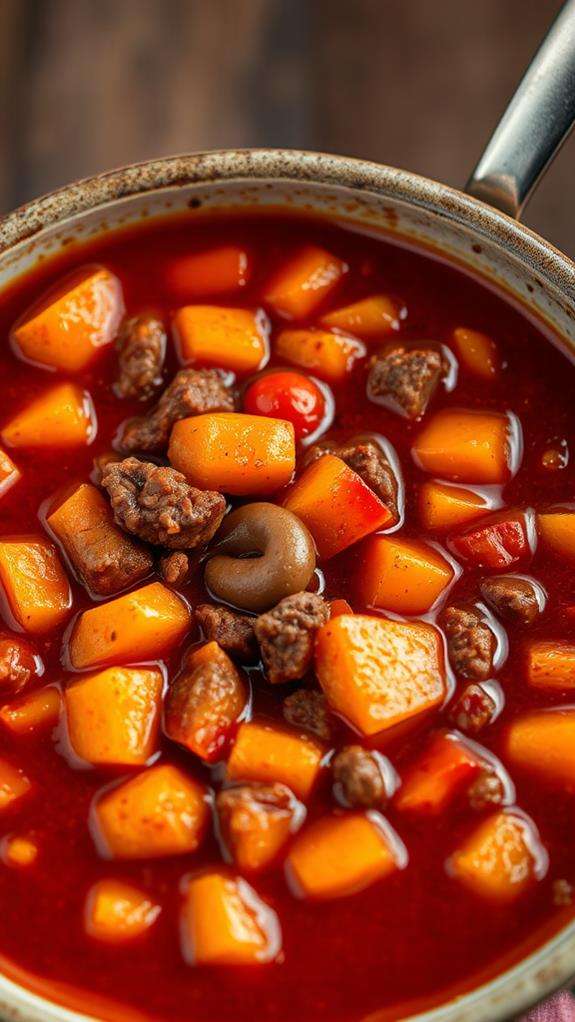
Root vegetables shine as excellent bean substitutes in chili, with sweet potatoes and squash leading the way. You'll find that sweet potatoes, typically one 6-inch potato per can of beans replaced, offer a natural sweetness that complements the savory elements of your chili. Their delicate sweetness mirrors the flavor profile of ingredients like gumbo crabs, adding a delightful twist to your dish the essence of Louisiana Bayou cooking. When you're chopping them, aim for consistent cube sizes to guarantee even cooking throughout the dish.
Butternut squash serves as another stellar option, bringing a creamy texture and vitamin-rich profile to your chili. You'll appreciate how both sweet potatoes and butternut squash maintain their structural integrity during the cooking process, preventing your chili from becoming mushy. They'll absorb your chosen spices beautifully, creating layers of flavor that'll enhance the overall dish. When you're preparing either ingredient, you don't need to worry about them breaking down too much – they'll hold their shape while becoming tender enough to blend perfectly with other ingredients. The added bulk and fiber content will make your chili satisfying and hearty, and you won't miss the beans at all. Plus, you're getting an excellent dose of vitamins A and C with every serving.
Mushrooms as Bean Replacements
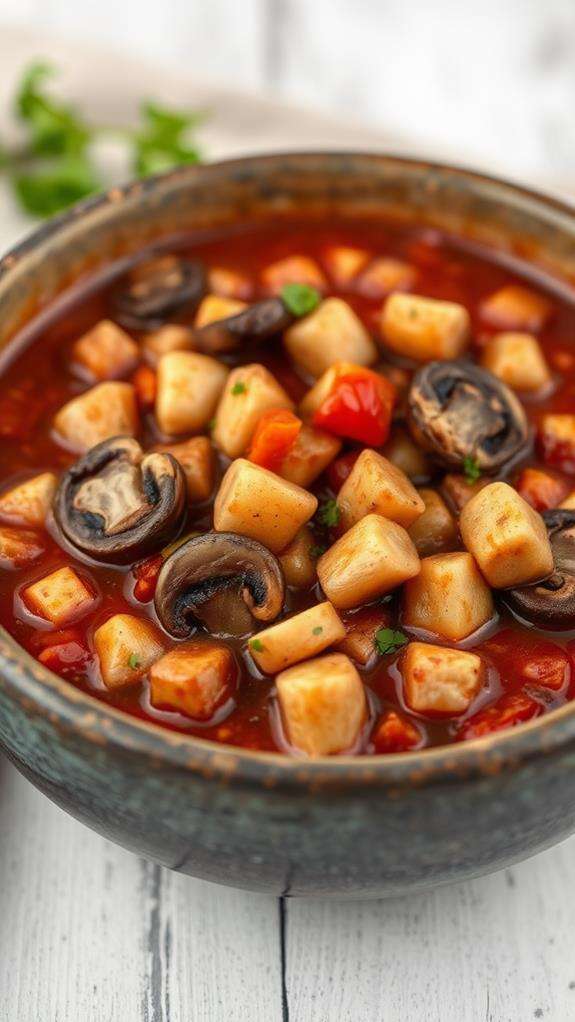
For those seeking an earthy alternative to sweet potatoes and squash, explore the rich world of mushrooms as your next bean substitute. When you're making chili, portobello mushrooms provide an excellent replacement thanks to their meaty texture and ability to absorb flavors. Additionally, mushrooms are known for their impressive health benefits, such as being rich in essential minerals like iron and zinc that support overall wellness. You'll want to start by dicing your mushrooms and cooking them first to release excess moisture, ensuring your chili maintains the perfect consistency.
For the best results in your bean-free chili, consider these key points:
- Replace each can of beans with 1 to 1½ cups of chopped mushrooms to maintain proper volume
- Combine different varieties like portobello, cremini, and button mushrooms for enhanced umami flavor
- Pre-cook your mushrooms to prevent excess water from diluting your chili's rich taste
You'll find that mushrooms not only mimic the hearty texture of beans but also bring additional nutritional benefits to your chili. They're packed with B vitamins and antioxidants while keeping the calorie count low. By incorporating mushrooms, you're creating a nutrient-rich dish that maintains the satisfying consistency you expect from traditional chili recipes.
Grain and Legume Substitutes
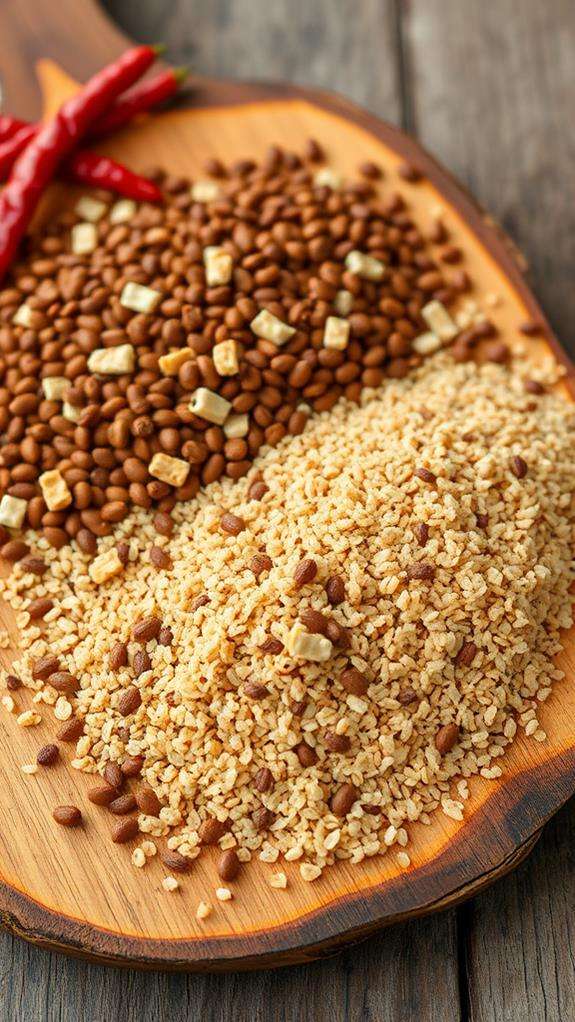
Many grain and legume alternatives can effectively replace beans in your chili while maintaining its protein-rich, hearty nature. Among these options, quinoa stands out as a versatile grain that'll provide a similar texture to beans while adding essential protein to your dish, making it an excellent choice for gluten-free diets.
You'll find that lentils, particularly red or green varieties, work wonderfully as bean substitutes in chili. They cook faster than traditional beans and pack a substantial amount of protein and fiber into your meal. When you're looking for a chewy texture, consider farro – just remember to cook it separately before adding it to your chili. For a creamy consistency, try split peas, which break down during cooking to create a thick, satisfying base. They're especially good at absorbing the rich flavors of your chili seasonings.
If you're seeking additional options, both rice and barley can increase your chili's volume while soaking up the savory spices. These grains provide a satisfying mouthfeel and help create that hearty texture you're looking for in a bean-free chili.
Texture and Volume Tips
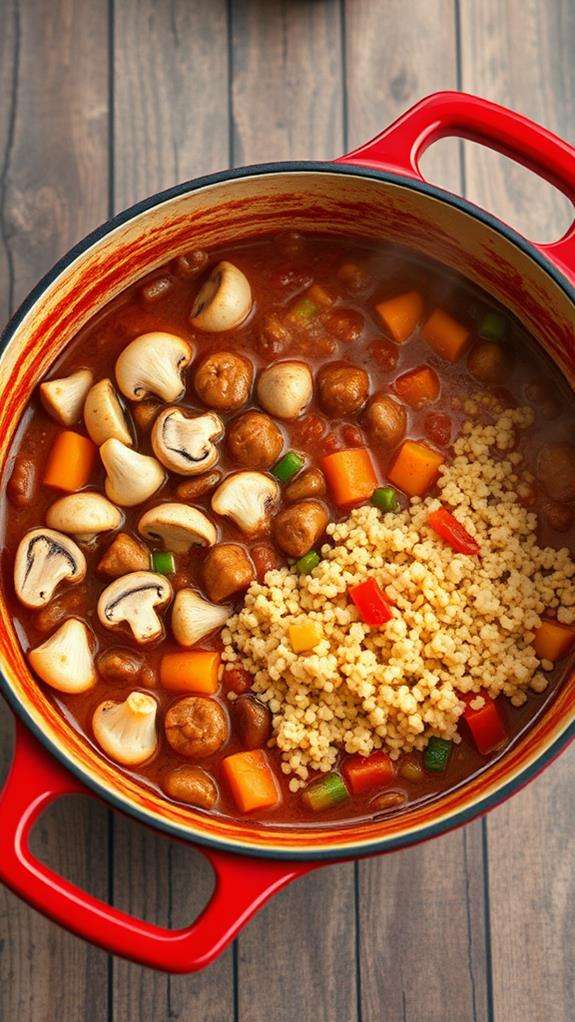
Maintaining the perfect chili texture without beans requires strategic ingredient additions and proper cooking techniques. You'll find that substitutions can actually enhance your chili's consistency while adding unique flavors and nutritional benefits.
- Ground meat serves as an excellent base, with an additional ½ pound replacing each can of beans you'd normally use
- Portobello mushrooms create a meaty texture while contributing to the rich, savory profile
- Cauliflower and sweet potatoes provide substantial bulk without compromising the classic chili structure
When you're working on texture balance, consider incorporating multiple substitutes simultaneously. For instance, you can combine ground meat with finely chopped cauliflower (1½ cups) to maintain heartiness while boosting nutritional value. If you're looking for a slightly sweet note, add a cubed 6-inch sweet potato, which will break down slightly during cooking to create a thicker consistency. For best results, cook quinoa separately before adding it to your chili, as this prevents the grain from absorbing too much liquid and maintains the desired texture. Remember to adjust your seasoning accordingly, as these substitutes may require more spices than traditional bean-based recipes.
Protein-Rich Replacement Ideas
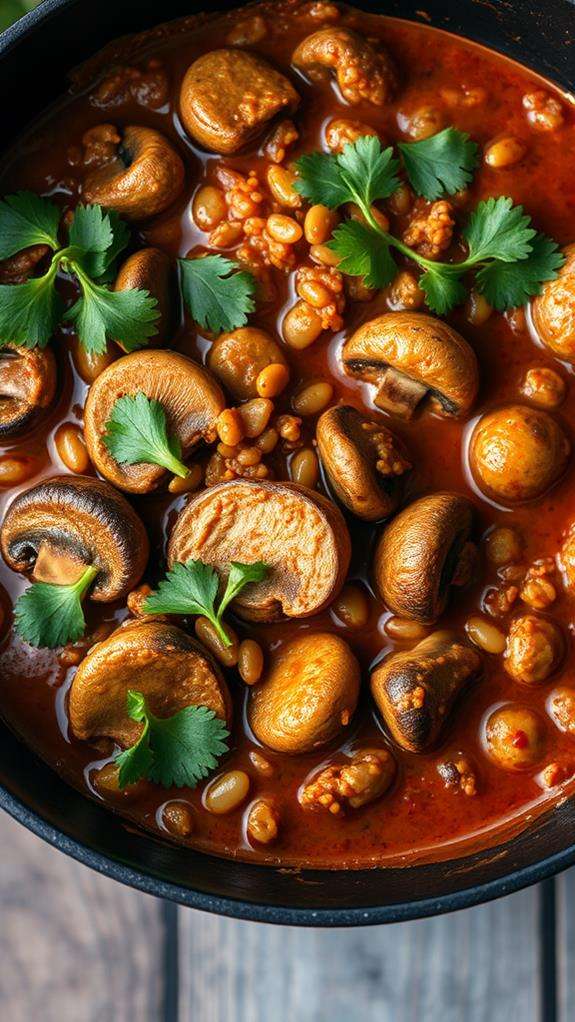
Concerned about protein content when skipping beans? You'll find plenty of nutritious alternatives that'll keep your chili hearty and protein-rich. Ground meat serves as one of the most straightforward substitutions, with ½ lb of beef, turkey, or chicken replacing each can of beans while maintaining robust protein levels.
For vegetarian options, you've got several protein-packed choices at your disposal. Tofu or tempeh can step in at 1 to 1½ cups per can of beans, delivering comparable protein content while adapting to your chili's bold flavors. If you're looking for something that'll blend more seamlessly, consider adding ½ cup of dry lentils, which cook down smoothly while providing essential nutrients. Texturized Vegetable Protein (TVP) offers another excellent meat-free alternative, mimicking ground meat's texture while boosting your chili's protein content. Don't overlook portobello mushrooms either – when chopped and added to your chili, they'll absorb the spices beautifully while contributing to the overall protein profile. These alternatives guarantee you won't sacrifice nutrition when customizing your bean-free chili recipe.
Low-Carb Bean Alternatives
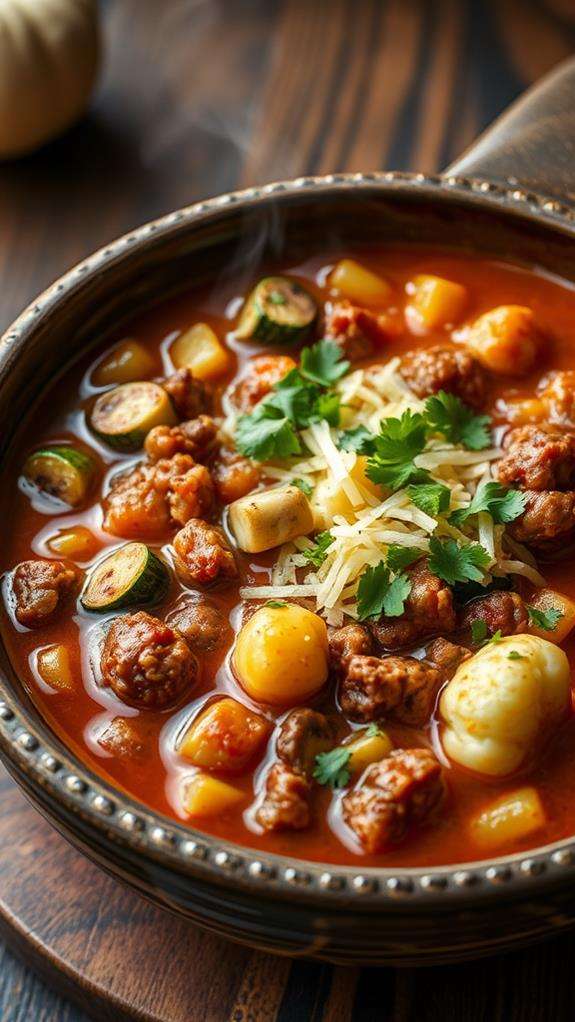
You'll find that extra ground meat makes an excellent low-carb replacement for beans in chili, adding necessary bulk while keeping the dish hearty and satisfying. Chopped cauliflower florets make a smart swap, as they'll absorb the chili's flavors while providing a tender texture that's similar to beans but with fewer carbs. Textured vegetable protein (TVP), a defatted soy product, works wonderfully as a bean substitute, offering the same chewy texture you're looking for while keeping carbohydrates minimal.
Extra Meat Adds Bulk
For those seeking a hearty chili without beans, extra meat serves as an excellent substitute that adds both bulk and protein to your recipe. You'll need about ½ pound of ground meat to replace each can of beans, ensuring your chili maintains its satisfying texture and robust flavor profile.
Here's what you can achieve by adding extra meat to your chili:
- Create a protein-rich, low-carb meal that's perfect for keto dieting
- Reduce cooking time to just 30 minutes, making it a quick weeknight option
- Customize flavors by mixing different types of ground meats
When selecting your meat options, you'll find that extra-lean ground beef (93% lean) works exceptionally well as your base. You can also experiment with turkey chili for a lighter alternative, or incorporate dark meat chicken for added richness. If you're feeling adventurous, try combining different meats like beef and pork to create unique flavor combinations. The beauty of using meat as a bean substitute lies in its versatility – you'll maintain the hearty, filling nature of traditional chili while keeping your carb count low and your protein intake high.
Cauliflower Instead of Beans
While meat provides a protein-rich alternative to beans, cauliflower offers a low-carb option that perfectly mimics the texture and bulk of traditional beans in chili. You'll need about 1½ cups of chopped cauliflower to replace each can of beans, ensuring your chili maintains its hearty consistency.
| Cauliflower Benefits | Implementation Tips |
|---|---|
| Low-carb nutrition | Chop into bean-sized pieces |
| Absorbs flavors well | Sauté before adding |
| Adds subtle creaminess | Use 1½ cups per can of beans |
| Maintains volume | Mix with other ingredients |
| Keto-friendly option | Enhances texture naturally |
To prepare your cauliflower for chili, chop it into small, uniform pieces that resemble the size of beans. You'll find that this versatile vegetable readily absorbs the rich flavors of your chili seasonings while adding a creamy element to the dish. For the best results, try sautéing the cauliflower before adding it to your chili – this extra step enhances both flavor and texture. If you're following a keto or low-carb diet, you'll appreciate how this substitution keeps your chili satisfying while greatly reducing the carbohydrate content.
TVP For Texture
Texturized Vegetable Protein (TVP) stands out as a protein-rich, low-carb alternative that perfectly mimics the texture of beans in chili. With an impressive 50 grams of protein per 100 grams, you'll find that this soy-based ingredient delivers the hearty consistency you're looking for in your chili without beans, while keeping carbohydrates minimal.
To get the most from your TVP when preparing chili, consider these essential steps:
- Hydrate your TVP in warm water or broth before adding it to your chili
- Season generously, as TVP readily absorbs spices and flavors
- Use the same volume as you would beans to maintain proper consistency
When you're creating chili without beans, you'll notice that texturized vegetable protein maintains the familiar mouthfeel you expect from traditional chili. The key to success lies in proper hydration – simply soak your TVP in warm liquid for about 10 minutes before incorporating it into your recipe. You'll find that it seamlessly integrates into your chili, providing that satisfying texture while keeping your dish low in carbohydrates and high in protein.
Best Spice Combinations

Creating the perfect spice blend stands at the heart of any delicious bean-free chili. When you're crafting your spice combinations, start with the foundational duo of cumin and chili powder, which will give your dish that authentic southwestern warmth while establishing a robust flavor base.
You'll want to layer your seasonings strategically. Begin by incorporating smoked paprika and oregano, which work together to create a deeper, more complex profile. For heat management, combine cayenne pepper with fresh minced garlic, adjusting the proportions to match your preferred spice level. Don't forget to add bay leaves during the simmering process, along with freshly cracked black pepper, as these ingredients will slowly release their flavors into your chili.
The final touch involves balancing your seasoning with tomato paste and salt. You'll find that tomato paste not only thickens your chili but also intensifies its savory qualities. Remember to taste and adjust your salt levels throughout cooking, as proper seasoning will amplify all other spices you've added. This methodical approach to spicing guarantees your bean-free chili maintains the rich, satisfying flavor you're looking for.
Frequently Asked Questions
What Can I Use Instead of Beans for Chili?
When you're in a pickle about replacing beans in chili, you've got several tasty options. You can use ground meat (beef, turkey, or chicken) at ½ lb per can of beans, or try 1½ cups of chopped vegetables like cauliflower and bell peppers. Sweet potatoes work great too – one 6-inch potato per can. Don't forget about red lentils (½ cup dry) or diced portobello mushrooms, which'll give you that perfect meaty texture.
What Is the Best Substitute for Beans?
Ground meat is your best substitute for beans, as it'll add protein while keeping the hearty texture you're looking for. You can use beef, turkey, or chicken, depending on your preference. If you're vegetarian, portobello mushrooms are your next best option – they provide a meaty texture and rich umami flavor. Both alternatives work well in the recipe, maintain the dish's consistency, and won't compromise its traditional taste.
What Is a Good Substitute for Beans in Keto Chili?
Like a master chef crafting the perfect meal, you'll find that ground meat is your best keto-friendly substitute for beans in chili. You can use beef, turkey, or chicken to maintain high protein while keeping carbs low. For extra texture, you'll want to add chopped cauliflower or zucchini. If you're vegetarian, extra-firm tofu or tempeh works wonderfully too, giving you that hearty, satisfying chewiness you're looking for.
What Is Chile Called Without Beans?
When you're making chili without beans, you'll commonly hear it called "chili con carne" (meaning "chili with meat") or "Texas chili." You'll find these terms used interchangeably in cookbooks and restaurants. While traditional chili recipes often include beans, both "beef chili" and "no-bean chili" have become popular descriptors for this meat-focused version. In Texas, you'll notice they simply call it "chili," as they consider bean-free preparations the authentic style.





